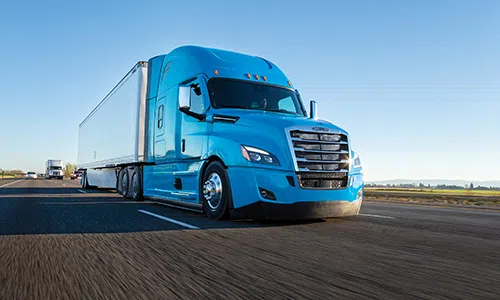The 2020 Freightliner Cascadia that will reach dealers this fall will offer new safety features, fuel efficiency and other technology compared with the previous model.
Daimler Trucks North America – the owner of the Freightliner brand and a sister company to Mercedes-Benz – is upgrading the safety system. It will now integrate the antilock brakes with cameras and radar signals that allow the truck to do most of the work of driving.
Cascadia’s top-of-the-line aerodynamic package smooths the exterior and closes gaps on the cab and chassis to push wind up and over the truck to improve fuel economy by up to 5 percent over the comparable 2019 model.
Optional technologies that keep the vehicle in its lane and automatically regulate the speed from 65 mph to 0 without the driver taking action will make the Cascadia the first commercially available Level 2 semi-autonomous truck as defined by the National Highway Traffic Safety Administration.
Here are five things to know about the truck:
1) Driver Assistance
Many competitors rely on advanced driver-assistance systems from suppliers Wabco Holdings Inc., Bendix Commercial Vehicle Systems and ZF Friedrichshafen. Daimler’s Detroit engine and technology unit, with help from Mercedes-Benz, has been designing its own system since 2014.The latest version is called Detroit Assurance 5.0.
Bumper-mounted radar and a high-definition camera at the top of the windshield work together to track up to 40 objects at a range of about 800 feet. The radar prioritizes six objects. The camera focuses on four. The data feed refreshes about 200 times per second.
Adaptive cruise control automatically sets a following distance of 3.6 seconds. A driver can manually adjust it to as little as 2.4 seconds. The system allows the driver to keep his feet on the floor and remove his hands from the steering wheel for up to 15 seconds. The rest of the time, he can rest his hands on the wheel as it steers by itself.
2) Emergency Braking
In rush-hour traffic congestion, the truck will creep along without driver intervention. If traffic stops, the truck will stop and hold its place. If traffic resumes moving in less than two seconds, the truck will begin moving, too. Longer stops require the driver to hit a resume button on the steering wheel.
When pedestrians are present, the system’s camera looks for hip movements instead of hip and arm movement because a walker whose head is buried in a smart phone is typically not moving his arms. When a pedestrian enters the truck’s path, the driver gets visual and audible warnings. The automatic emergency brakes pulse. If the driver doesn’t take action, the truck stops itself.
3) Blind-Spot Monitoring
The Cascadia has optional blind-spot monitoring consisting of two short-range radar sensors that cover the full length of the tractor and trailer. If the truck drifts into a lane with other traffic or tries to turn right in city traffic with objects in its blind spot, visual and audible alerts activate. The system also warns the driver backing the trailer if he is about to hit an object like a sign or a pole.
4) Lane-Departure Warning and Lane-Keeping Assist
When the Cascadia exceeds 37 mph, the optional lane-departure warning system activates. The camera system detects reflective paint and raised reflectors in lane markers. Crossing one of these without a turn signal activates a visual warning on the instrument panel and an audible warning from the left or right. If the driver ignores the warnings, the brakes will nudge the truck back into its lane.
When the system detects an object on the passenger side, a yellow triangle illuminates in the right-side pillar and the driver’s information display. If the driver drifts to the right or indicates a right-side lane change, the display turns red, and an audible warning sounds.
With the adaptive cruise control system on, a lane-keeping assist feature uses small movements to center the Cascadia in its lane. The system works at all speeds, but some curves may be too sharp for it to work. The driver can turn it off.
5) Fuel Efficiency
Every 2020 Cascadia comes with a standard A-pillar deflector that moves air down the side of the tractor. The deflector also helps keep side windows clean.
On the bumper, tow hook covers reduce the amount of air entering the front of the truck.
Optional aerodynamic features include 20- or 24-inch sealed side extenders that smooth air flow from the cab to the front of the extenders. A roof fairing deflector follows the path of the side extenders to improve airflow between the top of the truck and trailer. Wheel fairings close the gap between the tandem tires and the side of the truck. The front bumper is only 4 inches off the ground, but it snaps back into place if dislodged.
Freightliner claims its optional system that automatically lowers the suspension height of the cab 1 inch at 55 mph is an industry first. At highway speeds, the truck rides lower, reducing drag from air moving under it. At 45 mph, the truck returns to its original ride height.
To learn more about Freightliner visit: https://freightliner.com/
To learn more about Team Run Smart visit: https://www.teamrunsmart.com/





